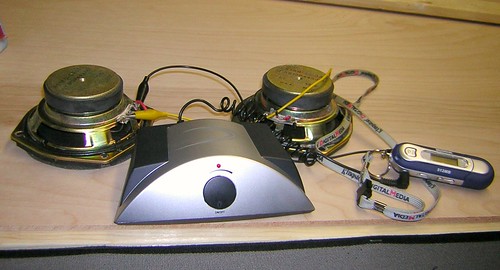A reader writes:
For various reasons, we still use wired landline phones at our house. I have an old 80's phone (first generation touch-tone) that belonged to my grandmother that I would like to continue to use. The only thing really wrong with it is the ringer.
It has an actual bell and clapper ringer. But the plastic posts that hold the bell in place inside the body of the phone have broken, so instead of ringing properly when it gets an incoming call, it just makes a feeble rattling sound. Since I'm not all that fond of the harsh sound of an old-style phone bell, what I would like to do is rip out that bell and replace it with the kind of electronic warble circuit that modern phones have.
First, what on earth are those modern ringer circuits called, and can one buy one or do I have to get a cheap phone and rip it apart? And second, is this a drop-in replacement, just solder the modern ringer in place of the bell and it will work, or is it more complicated than that?
And finally, are there instructions out there on the net for doing something like this and I just haven't found the magic search term that will get Google to take me there?
I tried googling this question a few times, but the signal to noise ratio of people talking about unrelated phone topics was too bad and I always came up empty. And then I realized, Hey, if I send Dan a few bucks I'm pretty sure he knows the answer and I will have saved myself a lot of time and frustration.
Glaurung
(And he did, indeed, send me a few bucks!)
The basic parts of old-fashioned phones - from the Bakelite era - should all be interchangeable, because they're just passive and electromechanical components powered by, and dependent upon, the phone line to operate.
So if you were working only with gear of that era, before the pushbutton era, you could probably build a telephone using the earpiece from one phone, the mic from another, the ringer from another, and the pulse-dial mechanism from yet another.
I think the basic electrical characteristics of the Plain Old Telephone Service, and its modern equivalent which is full of high-tech networking gear that pretends to be the POTS as far as phones are concerned, are about the same around the world.
The phone line constantly provides about 48 volts at low current to run telephone systems. (It's sometimes called minus 48 volts, because the phone system is "positive ground", to reduce corrosion of underground components. The power supply wires are at about -48V relative to the power returns and ground.)
The phone line tells a phone to ring by superimposing about 90 volts at about 20Hz AC on the normal 48V DC. When you pick the phone up and it goes "off hook", the line voltage drops to single-digit volts, and your phone should draw double-digit milliamps of current, at most.
(There's a long-lived strain of Magical Free Energy Machine that claims to allow you to tap useful power from the phone company's battery banks, taking advantage of that 48 volts that's sitting there all the time. Actually, the continuous current consumption of a phone is supposed to be in the microamps and the entire subscriber loop isn't expected to draw more than ten watts. The phone company will notice and may get angry with you if your house draws even a few watts from the phone line. You can power a little LED reading lamp or similar low-current device from the phone line without much trouble; the free-power scammers usually promise that you can substantially reduce your electricity bill, though, which is not true.)
Modern phones with transistors in 'em react to these different voltage conditions by doing what the old phones did, only fancier. This presents a problem for you, because when everything's controlled by a circuit board that activates different things in response to different input voltage characteristics, there's not necessarily a simple "ringer" that can be removed and put in another phone.
I wouldn't be at all surprised, though, if you could take the circuit board of a modern phone, with ringer attached but no handset any more, and just stuff it inside the casing of an old phone that still has everything but a ringer (just removing the half-broken bell mechanism would do the job there). Wire the newer phone's board in parallel with the old phone's parts and it ought to work. You may be violating a law or two by connecting an unapproved home-made device to the public telephone system, but if it's electrically the same as the original two phones plugged into a Y-adapter, I don't see any potential for real harm.
I'm not certain about this, though, and welcome input from commenters who've monkeyed with phones more than I have.
(Oh, and if you just want to reconstruct the broken plastic parts inside the phone, that's a perfect job for polycaprolactone, the nylon-like plastic that softens in hot water or a barely-warm oven and can be used, and reused, to make plastic parts of any shape. The main problem with hastily-squished-together polycaprolactone parts is that they tend to look blobby and weird, or spookily organic, but that doesn't matter for parts that're inside a casing that nobody will see.)















